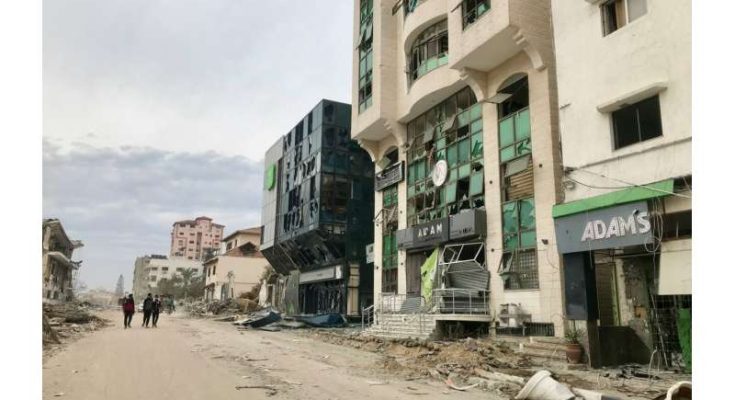For more than a year, the Israeli state has been engaged in a massive incursion into Gaza following the October 2023 Hamas attack against Israel.
In March 2024, Francesca Albanese, the United Nations Special Rapporteur on the situation of human rights in the Occupied Palestinian Territories, announced: “There are reasonable grounds to believe that the threshold indicating the commission of the crime of genocide…has been met.”
A core element of genocide includes food militarization and weaponization, a tactic that has been used by Canada to exterminate, dispossess and control Indigenous populations.
We have come together as a group of critical food systems scholars to examine the parallels between the weaponization of food in Gaza and Canada to bring about the systematic destruction of Indigenous Peoples. But we’ve also observed that food has been a powerful tool of resistance and resurgence.
Food as a weapon
Throughout modern history, food has been deployed as a weapon by colonial regimes to control and displace Indigenous populations. The current crisis in Gaza has brought this into sharp focus as the Israeli state has engaged in the systematic destruction of Palestinian food systems, with devastating consequences.
Israel’s blockade of Gaza, in place since 2007, has cut off access to essential agricultural areas and restricted fishing activities. Gaza farmers are often unable to access their land, while fishers are constantly barred from accessing the coast, harassed, intimidated and even killed by Israeli forces.
This blockade, combined with military operations that destroy farmland, trees and infrastructure, has resulted in more than 95 percent of people in Gaza facing severe food insecurity and a famine declared by the United Nations experts in the summer of 2024.
Canada’s use of food weaponization
Throughout the 19th and 20th centuries, the Canadian government employed similar tactics to restrict Indigenous Peoples’ access to land, food and water. Colonial policies like the Indian Act, the Homesteading Act and the Pass System confined Indigenous Peoples to reserves, prohibited hunting and fishing and forced reliance on inadequate government food rations.
This led to malnutrition and starvation, particularly in response to Indigenous resistance to settler expansion. The use of food as a weapon was part of a broader project to eliminate or otherwise undermine Indigenous identity and self-determination, a process that continues today.
From ongoing boil-water advisories to environmental degradation caused by mining, oil and gas extraction, forestry, agriculture and chemical production, settler governments and industries continue to dispossess Indigenous Peoples from their lands and undermine their livelihood.
These practices have severely and disproportionately impacted Indigenous health and well-being, as well as their food systems.
Israel targets food infrastructure
In the occupied Palestinian territories, Israeli control over land and resources reflects a similar colonial dynamic. Laws like the Absentee Property Law of 1950 facilitated the expropriation of Palestinian land.
Meanwhile, the Israeli military has systematically targeted Gaza’s food infrastructure and used starvation as a weapon of war, according to Human Rights Watch. Satellite imagery shows that 70 percent of Gaza’s tree cover has been eliminated or damaged, and about one-third of greenhouses have been demolished.
Tanks and trucks have decimated orchards, field crops and olive groves.
An estimated 800,000 tonnes of asbestos among the debris of destroyed buildings will result in asbestos-related diseases for generations to come. Under the Geneva Conventions, destruction of civilians’ means of survival and starvation as a tool of warfare is strictly prohibited.
Food as resistance
Food has also long been mobilized as a powerful tool of resistance. Among Palestinians, struggles for food sovereignty have played a critical role in self-determination.
Palestinians continue to cultivate their land under the rubble, grow olive trees despite ongoing violence and maintain food practices that connect them to their lands and their cultural heritage.
Similarly, Indigenous nations and communities across Canada have used food as a form of resurgence. Alongside land back movements, efforts to revitalize Indigenous food systems—such as hunting, fishing, growing and gathering—are central to movements for Indigenous sovereignty.
Learning about and enacting traditional food practices are important acts of resistance, as these practices sustain communities, strengthen connections to land and assert rights over the unceded territories Indigenous Peoples are fighting to reclaim. By reclaiming and rebuilding their land and food systems on their own terms, they continue to challenge colonial structures.
Food, colonialism and resistance
The destruction of food systems in Gaza and Canada is part of a larger effort of land dispossession and capitalist accumulation. By severing Indigenous Peoples’ connection to their food systems, settlers and colonial regimes have sought to control not only the land but also the people who depend on it.
Yet, through food sovereignty movements, these same populations are reclaiming their right to self-determination and building global networks of solidarity.
The struggle for food sovereignty is inseparable from broader struggles for land, justice and self-determination.
Connecting the dots between the Palestinian territories and Canada provides powerful examples of global colonial relations and struggles for justice and self-determination. It challenges us to critically examine the role of food in these struggles and demand government accountability.
Provided by The Conversation





